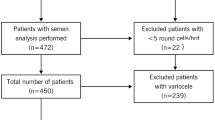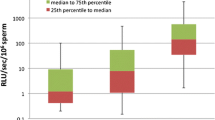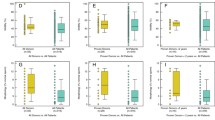Abstract
Purpose
Although the significance of leukocytospermia in semen remains controversial, evidence exists that white blood cells (WBCs) may adversely affect sperm function and act as a potential cofactor in male infertility. Nevertheless, the mechanisms by which leukocytes may alter sperm function in vitrois unknown. Recent investigations suggest that reactive oxygen species (ROS) generated by the polymorphonuclear (PMN) granulocytes could adversely affect sperm function. The objective of this study was to investigate the relationship between the presence of leukocytospermia as determined by the Endtz test and the excessive formation of ROS.
Methods
The WBC concentration and ROS formation in human semen, obtained from men consulting for infertility, were assessed and compared to that of normal donors. ROS was measured by a chemiluminescence assay using luminol and a Berthold luminometer. The WBC concentration was determined with a myeloperoxidase staining technique (Endtz test). Specimens were obtained from 94 subjects (20 donors, 74 patients).
Results
Of the 20 donors, 2 were Endtz positive and ROS positive; 18 were Endtz negative with 2 (11%) ROS positive. In the patient group (n=74), 26 (35%) were ROS positive, and 17 were Endtz positive and found to be ROS positive. Of the 57 Endtz-negative patients, 9 (15%) were ROS positive. The positive Endtz test results correlated strongly with positive ROS formation in patients and donors (P<0.001).
Conclusions
Our results indicate that the simple, costejficient Endtz test could be used as an indicator of excessive ROS formation in semen.
Similar content being viewed by others
References
Barratt CLR, Bolton AE, Cooke ID: Functional significance of white blood cells in the male and female reproductive tract. Hum Reprod 1990;5:639–648
Wolff H, Politch JA, Martinez A, Haimovici F, Hill JA, Anderson DJ: Leukocytospermia is associated with poor semen quality. Fertil Steril 1990;53:528–536
Berger RE, Karp LE, Williamson RA, Koehler J, Moore DE, Holmes KK: The relationship of pyospermia and seminal fluid bacteriology to sperm function as reflected in the sperm penetration assay. Fertil Steril 1982;37:557–564
Maruyama DK, Hale RW, Rogers BJ: Effect of white blood cells on thein vitro penetration of zona-free Hamster eggs by human spermatozoa. J Androl 1985;6:127–135
El-Demiry MIM, Joung H, Elton RA, Hargreave TB, James K, Chisholm GD: Leukocytes in ejaculate from fertile and infertile men. Br J Urol 1986;58:715–720
Tomlinson MJ, Barratt CL, Bolton AE, Lenton EA, Roberts HB, Cooke ID: Round cells and sperm fertilizing capacity: the presence of immature germ cell but not seminal leukocytes are associated with reduced success ofin vitro fertilization. Fertil Steril 1993;58:1257–1259
Tomlinson MJ, Barratt CL, Cooke ID: Prospective study of leukocytes and leukocyte subpopulations in semen suggests they are not a cause of male infertility. Fertil Steril 1993;60: 1069–1075
Kovalski NN, de Lamirande E, Gagnon C: Reactive oxygen species generated by human neutrophils inhibit sperm motility: protective effect of seminal plasma and scavengers. Fertil Steril 1992;58:809–816
Aitken RJ, West KM: Analysis of the relationship between reactive oxygen species production and leukocyte infiltration in fractions of human semen separated on Percoll gradients. Int J Androl 1990;13:433–451
Kessopoulou E, Tomlinson MJ, Barratt CL, Bolton AE, Cooke ID: Origin of reactive oxygen species in human semen: spermatozoa or leukocytes. J Reprod Fert 1992;94:463–470
Wolff H, Panhans A, Zebhauser M, Meurer M: Comparison of three methods to detect white blood cells in semen: leukocyte esterase dipstick test, granulocyte elastase enzyme immunoassay, and peroxidase cytochemistry. Fertil Steril 1992;58:1260–1262
D'Agata R, Vicari E, Moncada ML, Sidoti G, Calogero AE, Fornito MC, Minacapilli G, Mongioi A, Polosa P: Generation of reactive oxygen species in subgroups of infertile men. Int J Androl 1990;13:344–351
Kovalski NN, de Lamirande E, Gagnon C: Determination of neutrophil concentration in semen by measurement of superoxide radical formation. Fertil Steril 1991;56:946–953
Endtz AW: A rapid staining method for differentiating granulocytes from “germinal cells” in Papanicolaou-stained semen. Acta Cytol 1974;18:2–7
Krausz C, West K, Buckingham D, Aitken RJ: Development of a technique for monitoring the contamination of human semen samples with leukocytes. Fertil Steril 1992;57:1317–1325
Alvarez JG, Touchstone JC, Blasco L, Storey BT: Spontaneous lipid peroxidation and production of hydrogen peroxide and Superoxide in human spermatozoa-superoxide dismutase as major enzyme protectant against oxygen toxicity. J Androl 1987;8:338–347
Shekarriz M, Thomas AJ, Agarwal A: Incidence and level of seminal reactive oxygen species in normal men. Urology 1995;45:103–107
Jochum M, Papbst W, Schill B: Granulocyte elastase as a sensitive diagnostic parameter of silent male genital tract inflammation. Andrologia 1986;18:413–419
World Health Organization: WHO Laboratory manual for the examination of human semen and semen-cervical mucus interaction. Cambridge, The Press Syndicate of the University of Cambridge (3rd ed), 1992
Author information
Authors and Affiliations
Additional information
Supported by a grant from the Cleveland Clinic Foundation, Cleveland, Ohio.
Rights and permissions
About this article
Cite this article
Shekarriz, M., Sharma, R.K., Thomas, A.J. et al. Positive myeloperoxidase staining (Endtz test) as an indicator of excessive reactive oxygen species formation in semen. J Assist Reprod Genet 12, 70–74 (1995). https://doi.org/10.1007/BF02211372
Received:
Accepted:
Issue Date:
DOI: https://doi.org/10.1007/BF02211372




